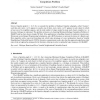Free Online Productivity Tools
i2Speak
i2Symbol
i2OCR
iTex2Img
iWeb2Print
iWeb2Shot
i2Type
iPdf2Split
iPdf2Merge
i2Bopomofo
i2Arabic
i2Style
i2Image
i2PDF
iLatex2Rtf
Sci2ools
COLOGNETWENTE
2010
2010
A Branch-and-price Approach to the k-Clustering Minimum Biclique Completion Problem
Given a bipartite graph G = (S, T, E), we consider the problem of finding k bipartite subgraphs, called "clusters", such that each vertex i of S appears in exactly one of them, every vertex j of T appears in each cluster in which at least one of its neighbors appears, and the total number of edges needed to make each cluster complete (i.e. to become a biclique) is minimised. This problem is known as k-clustering Minimum Biclique Completion Problem (kMinBCP) and has been shown strongly NP-hard. It has applications in bundling channels for multicast transmissions. We present several Integer Programming formulations, and a SDP relaxation, to motivate the choice of a Branch-andPrice algorithm with a non-trivial branching rule, which takes advantage of a new metaheuristic based on Variable Neighborhood Unfeasible Search (VNUS). Extensive computational results show that this approach outperforms other state-of-the-art approaches proposed in the literature, allowing to solve to opt...
Biclique Completion Problem | COLOGNETWENTE 2010 | Neighborhood Unfeasible Search | Optimization | Variable Neighborhood |
| Added | 21 Mar 2011 |
| Updated | 21 Mar 2011 |
| Type | Journal |
| Year | 2010 |
| Where | COLOGNETWENTE |
| Authors | Stefano Gualandi, Francesco Maffioli, Claudio Magni |
Comments (0)

